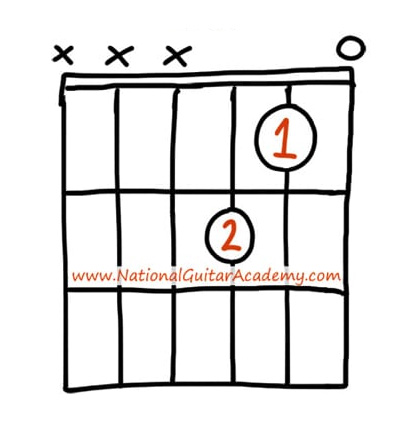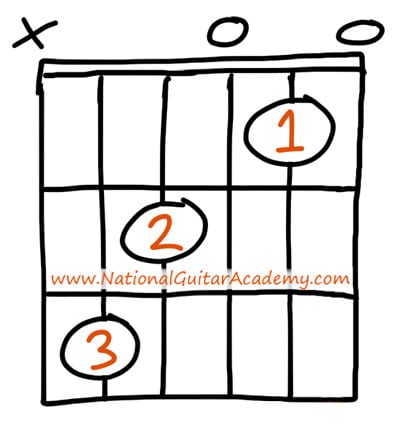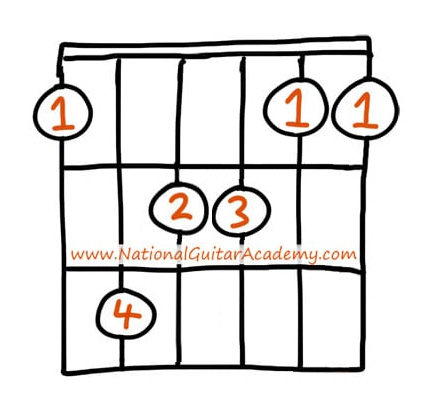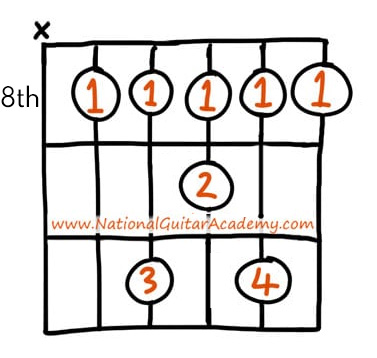The Fmaj7 guitar chord is a cool-sounding jazzy chord that’s fun to play.
In this lesson we’ll share our favourite ways to play this chord as well as some bonus tips and extra voicings.
In this free lesson you will learn:
- The easiest way to play the Fmaj7 guitar chord
- 2 cool intermediate and advanced voicings of this chord
- Why Fmaj7 is such a gorgeous chord to know and play
- Examples of the Fmaj7 guitar chord in songs
- The theory that underpins this beautiful chord
Over 100,000 guitar-learners get our world-class guitar tips & tutorials sent straight to their inbox:
Click here to join them
Get our best guitar tips & videos
Everyone can play the Fmaj7 guitar chord
The Fmaj7 guitar chord is interesting, beautiful, and easy to play. It’s used in folk, rock, pop, and jazz music, so it’s an unusually versatile chord.
If you are a beginner, there are easy and effective ways to play the Fmaj7 guitar chord with just two or three fingers. You can get the full (lovely) effect of the Fmaj7 chord in a simple formation.
- Beginner players can also use the Fmaj7 guitar chord as an easily playable substitute for its more complicated counterpart, the F chord. (Or to use its full name, ‘F Major’.)
- So there’s an easy version of the Fmaj7 guitar chord, but this chord also has a lot of options for intermediate and advanced players, involving barre chords and moveable shapes.
So whether you are waiting for your guitar skills to catch up to the F major chord or you want to jazz up your chord vocabulary, the Fmaj7 guitar chord is here and ready for you, to make your playing more beautiful today.
The easiest-of-all version of Fmaj7
If you are an absolute beginner and you have run across an Fmaj7 guitar chord for a song you are trying to learn, you can play this substitute chord with just two fingers across three strings.
It’s technically not an Fmaj7 chord, but it sounds very similar.
- Your second finger goes on the G (3rd) string, second fret.
- Then your first finger goes on the B (2nd) string, first fret. The E (1st) string is open.
- You do not have to deal with the other three strings (4, 5, and 6), so while you are strumming, try not to hit them.
This is an easy chord you can use as a substitute for the Fmaj7 guitar chord:
Fmaj7 (substitute)
(If you don't understand the above image please read our article "How To Read Guitar Chordboxes In 60 Seconds". It will make everything clear!)
Theory Tip: This is called a rootless chord voicing (which is quite rare) because although it carries the effect of the Fmaj7 guitar chord in the context of the song you are playing, it does not contain an F note, which is the note the chord is named after and the root of the chord.
Pro Tip: This Fmaj7 substitute also doubles as an A minor chord (because it contains A, C, and E, all three notes of the A minor chord).
After you have mastered this simple ‘substitute’ version of the Fmaj7 guitar chord and are ready to move on, it’s time to try the full ‘standard version’ of the Fmaj7 chord.
Learn 12 EASY beginner chords with our popular guide


Where should we send it?
✅ Stop struggling. Start making music.
✅ Learn beginner-friendly versions of every chord.
This is our most popular guide and it will improve your chord ability quickly! 😎
Get your own personalised guitar-learning plan 🎸
Get a custom guitar-learning plan here: Click here for GuitarMetrics™
World-Class Guitar Courses 🌎
Learn from the world's best guitar educators: Click here for our guitar courses
The ‘standard’ way to play the Fmaj7 guitar chord
If you are ready to try a full version of the Fmaj7, congratulations! You are about to level up your playing with a truly beautiful new sound.
Fmaj7 (standard version)
- This four-string Fmaj7 guitar chord voicing is found in plenty of amazing songs, so once you are able to play it and move in and out of it, you will be able to add this to your repertoire in no time.
- To make this version of the Fmaj7 guitar chord, you are going to add one finger on to the two-finger version we showed you earlier.
Skill Tip: Don’t play the A (5th string) and low E (6th string) when strumming this voicing of the Fmaj7 guitar chord. The A string won’t sound terrible, because that is a note that lives in the chord, but the low E will jumble things up at the lower end and make the chord sound muddy.
There is a gorgeous song that uses this Fmaj7 as an arpeggio at the very beginning. It’s on piano, but the chord is the same. Check out this lovely song by Chicago:
Before we look at some more voicings of the Fmaj7 guitar chord, let’s discuss a few bits of theory.
Quick Tip: Naming Fmaj7 guitar chords
There are a few ways to abbreviate the Fmaj7 guitar chord.
Its full name is “F major seven”, and you may see it written as Fmaj7, Fma7, FΔ7, or FM7 (with a capital M, distinguishing it from Fm7, with the lowercase ‘m’, which would denote F minor seven).
No matter which way you see it written, they all mean the same thing! 🙂
When does the Fmaj7 guitar chord usually appear?
The Fmaj7 guitar chord is part of the C major and F major chord families, two guitar-friendly keys.
It appears most often alongside the C major chord, but it is also used in other keys as a surprise chord for a sudden change in the feel of the song.
There are plenty of songs that you can play using the Fmaj7 guitar chord. Listen to this example by David Bowie, using the Fmaj7 chord at the start time of the video:
.
Note: If you don’t understand how keys work, check out this guide: Guitar Keys: The Essential Guide
Theory Tip: The role of the Fmaj7 in chord progressions
The Fmaj7 guitar chord lives in a lot of chord progressions as a structural chord and also a passing chord, meaning that sometimes it is a very important chord and sometimes it is more of an ‘ornamental’ chord in a song.
- Fmaj7 is most commonly found in one of two jobs. The first is as a “home base” chord, or I chord.
- That means that Fmaj7 is the harmonic center of the song, the chord of the song’s key, and all other chords in the song have some relation back to it. (The Chicago song above is a good example of a song that uses Fmaj7 as the I chord.)
- The other function the Fmaj7 guitar chord often has is as a IV chord, which follows the I chord to lead the ear away from the I chord.
- The Fmaj7 chord is the IV chord in the key of C major, so when C major is the I chord, Fmaj7 (as well as the F major chord on which it is based) is the IV chord.
This means C and Fmaj7 work really well together.
Try this simple chord combination, C major to Fmaj7, to hear how the I-IV relationship works and to practice getting in and out of the Fmaj7 guitar chord:
C major
Fmaj7
If you switch every four beats between C major and Fmaj7, it may begin to sound familiar and suggest a song that you know.
Now you are on the path of exploration!
One song in the key of C major, using the C major to Fmaj7 progression, that you might be reminded of is “Band on the Run” by Paul McCartney and Wings. Listen to this section and you can hear the very same chords you are now playing.
Intermediate-level: The Fmaj7 guitar chord as a moveable shape
If you’re ready for more interesting ways to play the Fmaj7 guitar chord, you can try this more advanced version.
It takes some practice to jump your fingers into this shape, but it has a couple of advantages over the four-string voicing.
- First, this Fmaj7 guitar chord uses the low E (6th) string, so when you play it, it has a low bass note and sounds more full than the ‘standard’ four-string open chord version.
- Second, this chord shape is completely moveable. The root of the chord is on the low E string, so you can play ANY maj7 chord by locating the root of the maj7 chord you want to play on the low E string and moving this shape there.
GUITAR BLAST OFF! (Eleven extra chords with just one shape!!)
The shape of this Fmaj7 guitar chord is a barre chord, so you can move it up and down the neck. Take your time and try to formulate this shape. It’s a fiddly one to get, but compared to some other barre chord shapes it’s not nearly as hard to perfect as you think.
Fmaj7
(Barre chord version using a moveable E shape)
One more alternative: barre chord Fmaj7
This voicing of the Fmaj7 guitar chord uses a barred shape. It is located high on the neck and although it does not have the bass of the above voicing, it has a chiming sound that is wonderful to hear.
To make this Fmaj7 guitar chord, you have to go scouting on the A string for the F.
Tip: To go up one letter of the musical alphabet (A B C D E F G), you usually move two frets up the neck. There are only two exceptions to this rule: between B and C, and between E and F, you only go up one fret
>It looks like this:
Fmaj7
(Barre chord version using a moveable A shape)
Like the moveable shape Fmaj7 guitar chord above, this barre chord Fmaj7 shape can be used anywhere on the fretboard to make a maj7 chord voicing.
Wherever your first finger is on the A string is the root of the chord. Eleven MORE bonus chords! 🙂
Practice Tip: How to use the Fmaj7 guitar chord in a real song
- One way to practice the Fmaj7 guitar chord is to find a song you like that uses it as part of the progression.
- One easy song that uses this progression is “You Can’t Always Get What You Want” by the Rolling Stones. The two chords, C major and Fmaj7, take you all the way through the verse and most of the way through the chorus. Try playing and singing, if you know the song.
You can play “You Can’t Always Get What You Want” using the open C major chord and the four-string Fmaj7 chord.
You will not need another chord except in the chorus when you sing the word “try.” (That other chord is a D major.
You can also use a D7 and play the entire song without ever having to move your first finger. The chord after the D major is an Fmaj7, and after that, it’s back to C major – Fmaj7!)
Further improving your Fmaj7 guitar chord skills
It is always a good idea to practice new chords by themselves to start to develop muscle memory.
As you play the Fmaj7 guitar chord in any or all of the versions presented here, you will become better able to jump to the chord instead of putting your fingers down one at a time.
You can practice chord changes with another song that uses the Fmaj7 guitar chord as an important part of the progression, try “One” by U2. (The verse progression is Am – Dsus2 – Fmaj7 – G, and the chorus progression is C – Am – Fmaj7 – C.)
Try to play along with Bono!
Recommended resources
Here’s some more National Guitar Academy lessons you may enjoy:
14 Easy Guitar Chords For Beginners
F Guitar Chord – 3 Easy Alternatives
Easy Ways To Play The C Guitar Chord
What Type of Guitarist Are You?
Take our 60-second quiz & get your results: Take The Quiz
Join the world's best online guitar school 🌎
- Get your own personalised guitar learning plan (customised just for YOU).
- World-class online guitar courses. Learn at your own pace.
- Community Campus & Learning Forum - A friendly community! Connect with our team & students. 😊
- Beginner Song library with chordsheets, tabs and tips. (Songs suitable for all levels!)
- Regular live streams, seminars and Q&A sessions - Learn from world-class guitar educators. Get all your questions answered!
Click here to learn more about National Guitar Academy membership 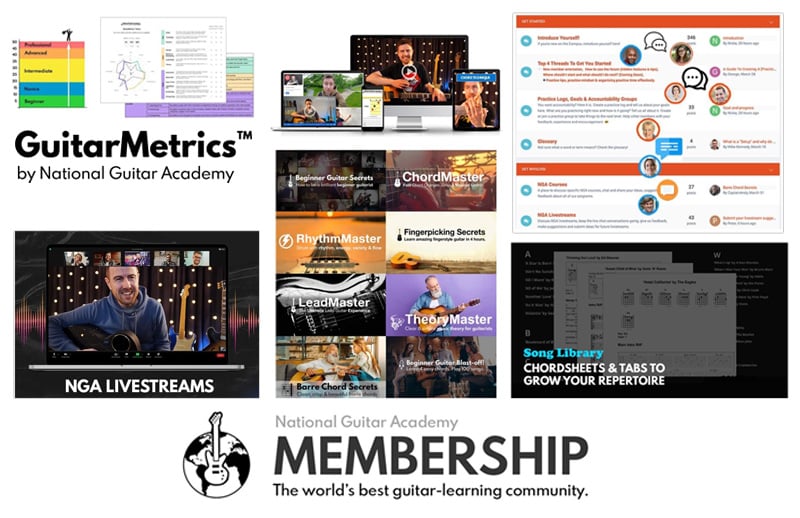
Cool Guitar T-shirts 😎
Look cooler! Check out our merch: Click here to see our merch store
Want free guitar tips and video lessons delivered to your inbox?
Join over 100,000 guitar-learners and subscribe to our guitar-tips-by-email service. (It's free.)
We'll send you a series of lessons that will move you to the next level of your guitar journey.
Learn how everything fits together quickly, easily and effectively. We share ninja tips (for instant fun!) but also timeless fundamentals that will deepen your understanding.


Get our best guitar tips & videos
Popular Lessons
How To Learn Guitar: An 11-Step Programme For Beginners
How To Choose The Perfect Beginner Guitar
More Cool Guitar Stuff
Learn about National Guitar Academy: About Us
Join us on Facebook for daily guitar tips.
Listen to our Learn Guitar Podcast for rapid guitar progress.
Check out our free chord lessons.



